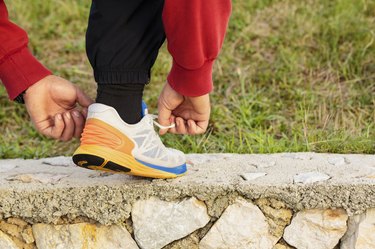
From sprinting to distance events in track and field, to cross-country races, deciding on whether a racing spike or a regular training shoe works for you is a key factor. While running spikes can enhance your performance because of their very minimal weight and aggressive traction, a more cushioned, more stable training shoe can protect you from injury much better.
Spike Types
Video of the Day
When you think of running spikes, you generally think of a sprinter using them because a sprinter requires everything spike footwear offers: minimal weight and aggressive traction. Although the shoe itself is referred to as a "spike," the actual spikes are sharpened metal or ceramic spikes that are screwed in the sole. Spikes are made for racing the sprint, middle distance and distance events on the track, and for the off-track, dirt and grass surfaces of cross country.
Video of the Day
Spike Type Differences
Because a sprinter runs almost the entire duration of his event on his toes, the lack of any type of cushioning in the spike provides minimal weight. A middle distance spike, while still having the sharp spikes in the bottom, does have a small amount of cushioning in its heel. This is because the farther you run, the more you hit your heel. A distance or cross country spike does provide cushioning, although still a minimal amount, from the mid-foot through the heel, because of more heel strike.
Regular Running Shoes
What is generally referred to as a regular running training shoe may provide more benefits for you via more cushioning and stability, but has a downside for racing because of its heavier weight and bulkiness. The book "Running Anatomy" by Joe Puleo and Dr. Patrick Milroy notes that because every foot strike when you run represents three to four times your body weight on impact, a proper training shoe provides more protection and is designed for your individual bio-mechanics.
Running Shoes Types
There are three main categories in standard running shoe design: Neutral--Designed for a nice-arched foot that does not roll in or over-pronate, and does not roll out or supinate. This shoe does not over-compensate laterally or medially. Stability--Designed for a lower-arched foot that has a moderate tendency to over-pronate. A moderate amount of denser material under the arch stabilizes the runner's foot. Motion Control--Designed for a flatter foot with little or no arch. Because of excessive over-pronation, this shoe has a maximum amount of arch support.
Warnings
When using running spikes, you should plan on using them in training to get used to them. The article, "A Guide for Running Spikes," says you may find spikes uncomfortable at first because of the lack of cushioning, and the sharp spikes located under the ball of your foot. There will be a period of adjustment until they become comfortable, and you may choose to use your regular running shoes for most of your training, and spikes for racing only.